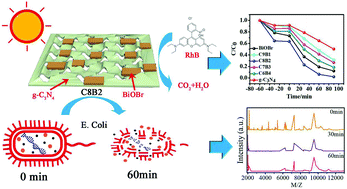Ultrasound-assisted two-step water-bath synthesis of g-C3N4/BiOBr composites: visible light-driven photocatalysis, sterilization, and reaction mechanism
Abstract
g-C3N4/BiOBr photocatalysts with different weight ratios were prepared by a two-step ultrasound-assisted water-bath deposition method. The materials were subsequently characterized by X-ray diffraction (XRD), scanning electron microscopy (SEM), photoluminescence spectroscopy (PL), transmission electron microscopy (TEM), the Brunauer–Emmett–Teller (BET) method, Fourier transform infrared spectroscopy (FT-IR), and ultraviolet-visible (UV-vis) diffuse reflectance spectroscopy (DRS). The photocatalytic activities of all samples were evaluated by the degradation of Rhodamine B (RhB) and Escherichia coli (E. coli) under visible light. The results revealed that C8B2 exhibited the highest photocatalytic activity among the samples tested herein. Moreover, electrochemical tests (the Mott–Schottky curve (MS), electrochemical impedance spectroscopy (EIS), and Tafel tests) and free radical trapping experiments were employed to analyze the flow direction of the photogenerated carriers in g-C3N4/BiOBr and the mechanism of the photocatalytic reaction.



 Please wait while we load your content...
Please wait while we load your content...